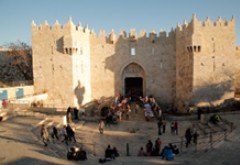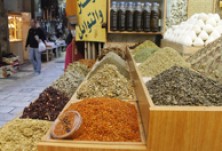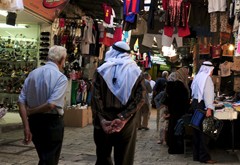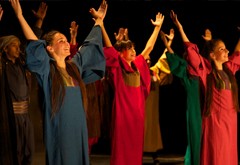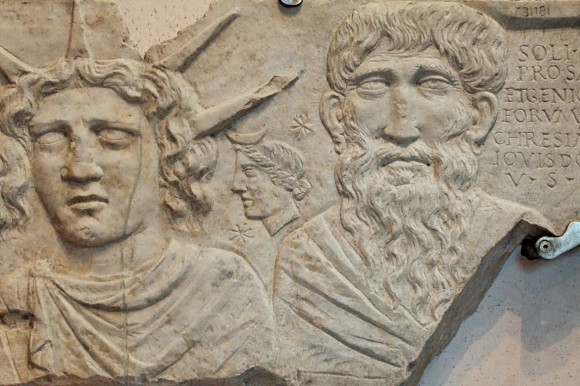Adopting Christianity as the official religion of the Roman Empire (Byzantine) in 324 AD, extending until 614 AD, did not fundamentally change the city plan, although a pervading phenomenon was to build churches, convents, hostels, and sacred tombs. It was, however, enlarged to adapt with the new religion and its requirements. The city center became the Holy Sepulcher area / church of the Martyr (Martyium), built in 335 AD at the order of St. Helena, mother of Emperor Constantine (ruled 306 - 337 AD), designed by Zenubius, the Arab engineer from Palmyra, after the city was expanded to the west in order to have a church in its center. It is also said that the Holy Sepulcher was built on top of the remains of the Temple of Venus, making it not only the center of Jerusalem, but world Christianity as well. Christianity did not start in Jerusalem with Constantine. Evidence indicates the presence of various Christian groups with increasing powers since the first century AD. There are also references to a clerical church starting the second century AD, and this presence was reinforced during the third century. There is also evidence of Christian worship sites during the second century AD.
Jerusalem maintained the name Aelia, after deleting Capitolina, and its religious status was raised to the level of a Patriarchate, making it one of the five patriarchate cities of Rome, Constantinople, Antioch, Alexandria, and Jerusalem. It was hence transformed into a Christian pilgrimage and monastic city.
The growth in the phenomenon of building churches and different Christian institutions required the expansion of the city of Jerusalem to include the new establishments. In addition to expanding west, the city also expanded south, to include mount Zion and the famous Silwan pool. Furthermore, building churches outside the city walls became commonplace, particularly on the Mount of Olives and its western slopes. This expansion was the largest in the history of the city, before the second half of the 19th century, and this is where the international dimension of Jerusalem started, increasing across the ages, and influencing its history and shape. Adopting Christianity in Jerusalem did not mean that Christians became a majority in the city. Evidence indicates that paganism continued to exist rather strongly, but was not the main religion any more. Furthermore, Christianity was not persecuted any more after it became the official religion of the state, excluding the rule of Emperor Julian the Apostate (361 - 363 AD), who rebounded fromChristianity and tried to restore the glory of paganism.
Over the next three centuries, the city enjoyed a period of relative stability, tainted only by periods of bad governance and religious struggles. Churches and convents continued to expand throughout the city, merging with the Roman planning. It is also possible to talk, during this period, about the holy geography and the civilized scene, and their influence on the city form.
It is also possible to identify twenty churches and convents that were built during this Byzantine period, whose archaeological remains are still evident. There are also about 30 Byzantine churches and convents mentioned in the literature, but were not evident in antiquity and were not identified conclusively.
Doubtlessly, the period during which Queen Eudocia, wife of Emperor Theodocius II (ruled 408 - 450 AD) settled down in Jerusalem after being divorced or banished, contributed to developing the construction movement, expanding churches and building new ones.
In any case, two large and central churches were built during the reign of EmperorConstantine. The first is the Church of the Holy Sepulcher in 325 AD, mentioned earlier, which passed through many construction stages after the death of Constantine, and the second is the Church of Ascension on top of the Mount of Olives. A third church was also built on Mount Zion (HagiaSion) between the years 329 and 349 AD. At the time, Mount Zion was located inside the city. Mount Zion also enjoyed another huge church, namely, the Eleona Church. The area surrounding Jerusalem also witnessed the construction of a number of churches, most prominent of which are the Church of Getsemani (391 AD), the Silwan Church near the pool, and the St. Mary's Tomb Church (451 AD). A series of convents were also built, surrounding the city from all sides, most likely built by wealthy upper-class Roman women. The last and famous Byzantine church is the Nea Maria Church, located near the Zion Gate inside the city walls, extending outside it under the Ottoman wall, which was built in 543 AD by Emperor Justinian. This church was planned by the Arab Patriarch Elias, with Saint Saba. It used to be considered the largest church in Jerusalem, and comprised, in addition to the Basilica composed of three huge apses, a hostel for pilgrims, a convent, and two hospitals with over 100 beds for the pilgrims and a similar number for the residents of Jerusalem, in addition to a library and water wells.
The church-building activity and the increasing holiness of Jerusalem in the eyes of world Christianity attracted large numbers of poor and repentant people from all parts of the Christian world, which required building charitable institutions to feed, house, and treat them.
The map of Madaba (a city in southeast Jordan) represents a rich source for studying the Old City. Through it, one can interpret streets, public institutions, churches, and residential neighborhoods. It depicts a very close image of Jerusalem towards the end of 6th century AD (around 575 AD), and may have been made during the reign of Emperor Justinian, characterized by a period of renaissance.

